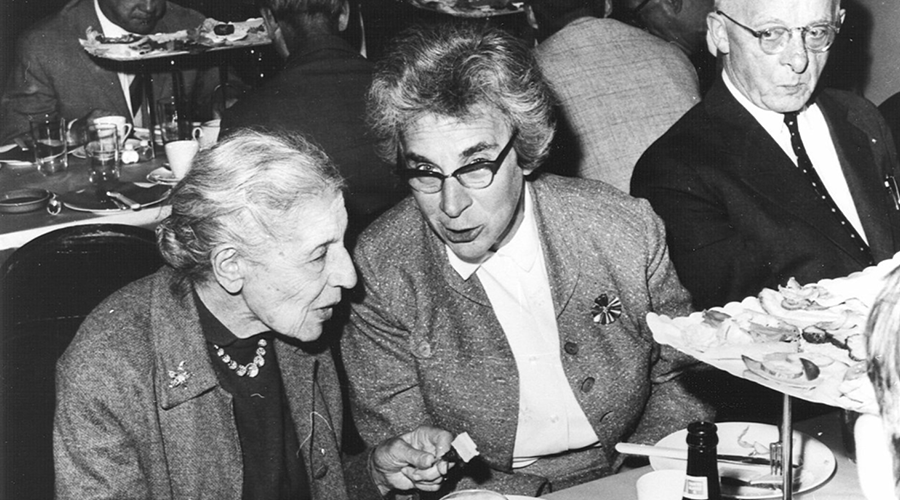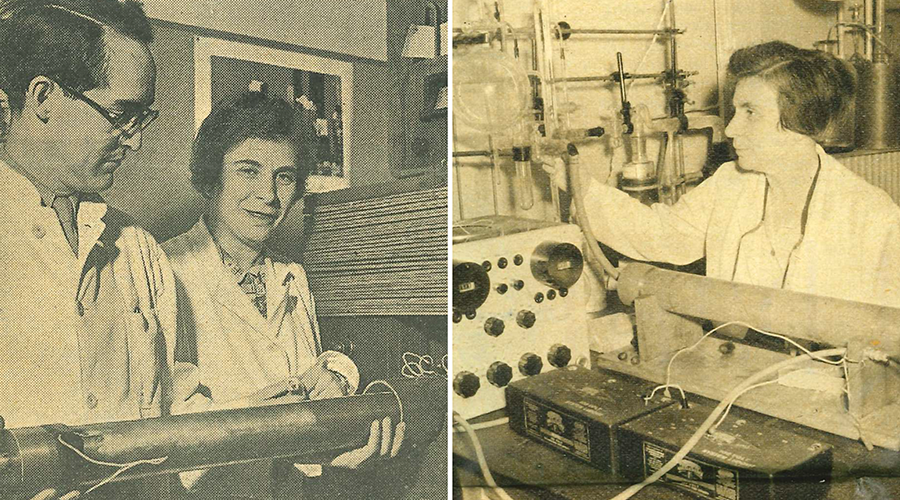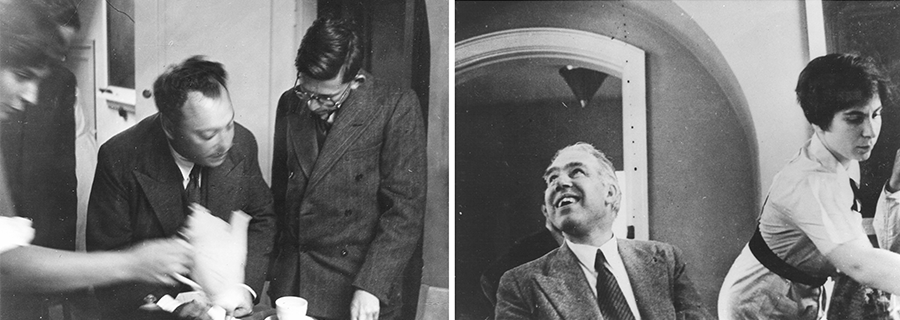
December 2023/January 2024 (Volume 32, Number 12)
Opinion: The Extraordinary Life and Science of Hilde Levi
Levi, a Jewish German-Danish physicist, escaped the Nazis in the 1930s. In the decades after, she built a diverse career that spanned from biophysics to radiation safety.
By Rebecka Mähring | November 14, 2023

Credit: Hilde Levi Collection, Niels Bohr Archive
Hilde Levi (center) and Lise Meitner at the University of Copenhagen Institute for Theoretical Physics in 1963.
The physicist Hilde Levi doubted that her life story would “ever be used for any purpose except to supplement,” modestly, the stories of other famous physicists.
She was wrong: Her story is remarkable. During her 50-year career, Levi — who was born in 1909 and died in 2003 — conducted research on the frontiers of biophysics, taught scientists and doctors in training, introduced radiocarbon dating to Denmark, drafted legislation on radioactive safety, and, after her “retirement,” became a science historian.
Levi’s story contributes to growing scholarship on how World War II impacted the careers of female Jewish physicists, and how women in science continuously renegotiate their identities in a predominantly male profession. And Levi’s career, which spanned diverse fields, challenges the idealized notion that all good scientists are intensely specialized.
Hilde Levi’s Life and Work
On Jan. 30, 1933, Levi, then a 23-year-old doctoral student in physics in Berlin, heard an announcement on the radio: Adolf Hitler had been named the Chancellor of Germany.
Levi wept at the news. “I realized that this was the end of my possibilities for a future in Germany,” she later recalled.
Despite her fear, Levi stayed in Berlin until she had finished her thesis and passed her final examinations in 1934. She then reached out to the Danish branch of the International Federation of University Women, which arranged with Niels Bohr for her to come to the Niels Bohr Institute. At the age of 25, Levi left her home and family and moved alone to Copenhagen.
Levi worked there as a research assistant for six years. In 1934, she and James Franck studied the physics of photosynthesis, co-authoring two papers on the fluorescence of chlorophyll. The next year, Levi began working and co-authoring papers with George de Hevesy, studying induced radioactivity in rare-earth elements and radioactive isotopes as tracers in biological processes, like animal metabolism. Because Hevesy traveled widely, Levi often experimented alone. She also assisted Otto Frisch extensively in 1935 and Lise Meitner briefly in 1939.
As Levi’s background was not in biophysics, she had to learn new concepts and techniques — and since radioisotopes were quite new, scientists at the Institute built much of the equipment themselves. With Franck, Levi assembled the optical bench and spectrographs; with Frisch, she built Geiger counters, amplifiers, and even advanced resistors that were not commercially available.

Credit: Hilde Levi Collection, Niels Bohr Archive
These newspaper clippings show Levi in the radiocarbon dating lab, originally housed in the cellar of the Zoophysiological Laboratory, in 1952 (left) and 1953.
Levi was also adept at fostering connections, befriending both male scientific staff and female secretaries and physicists’ wives. She went on evening bike rides and visited Copenhagen’s amusement park with colleagues, and even spent Christmas with the Bohr family.
Roles in science then were sharply divided by gender, and Levi also carried out menial tasks for her male colleagues. She acted as a “secretary and helper” for Franck, who asked her to “type letters for him or to make telephone calls for him and things of that kind,” she recalled, noting that she “didn’t mind at all.” In her later oral history, she mentions George Placzek, for whom she “had the great privilege, almost every day at lunchtime, to make scrambled eggs.” She regularly served coffee with the secretaries at conferences.
By April 1940, the German occupation of Copenhagen had largely forced Levi into hiding. She transitioned her work to the Carlsberg Laboratory, which was closer to her apartment. When the war stymied their supply of radioisotopes, Hevesy and Levi worked instead on using heavy water in biological research.
In September 1943, as the Nazis’ persecution of Jews intensified, Levi and other colleagues of Jewish descent, including Hevesy, fled to Stockholm. There, she resumed research on radioisotopes at the Wennergren Institute for Experimental Biology, until her return to Denmark in 1945.
After the war, Hevesy stayed in Stockholm, and Bohr discontinued biological research at the Institute, so Levi was recruited in 1946 to the Zoophysiological Laboratory in Copenhagen. There, she worked as a research assistant to biologist Hans Henrik Ussing — a major adjustment. “The way of thinking, the way of doing experiments, the way of organizing a laboratory” was “entirely different again” from her experiences in physics, she later said.
In the late 1940s, “the thought occurred to me and also to the others that maybe it was time for me to get out and look at the world outside Copenhagen,” she recalled. So during the 1947-48 academic year, Levi went to the U.S. for the first, but not the last, time. Although Levi initially planned to study tracer techniques with Franck, who was then at the University of Chicago, she was snagged by Willard Libby, also at UChicago.
That visit, and later ones, proved to be a turning point. Levi learned methods of experimental biophysics that were not well-known in Europe at the time, like how to handle radiocarbon, perform autoradiography, and date biological samples using the carbon-14 isotope. She also gained valuable contacts and secured independent funding sources.
In the three decades that followed, Levi’s work blossomed. In 1949, Levi began teaching a course at the Zoophysiological Laboratory on uses of radioisotopes in medicine (e.g., for imaging, and radiation therapy) and how to handle radioactive materials and operate relevant machinery. Since most of the students were medical professionals and scientists, lectures took place during evenings and at night. The courses were “so much in demand,” she recalled, that she taught several parallel courses each year until 1970.
Levi’s work also attracted the attention of archaeologists. In 1950, soon after her return to Copenhagen, Levi was contacted by archaeologists at the National Museum, who consulted her on the feasibility of dating samples using carbon-14. Levi’s expertise and American contacts enabled Denmark to build Europe’s first functioning dating machine by 1951. For the next 20 years, she was one of three scientists on a committee that decided which samples to date. Levi said later that the experience was “exceedingly interesting.”
Also starting in the 1950s, Levi began working on the regulation of radioactive materials. From 1952 to 1970, she consulted for the Danish National Board of Health and helped draft Denmark’s first laws around radiation protection, which regulated the purchase and storage of radioisotopes. This legislation was new in Europe in the 1950s — only the U.S. had expertise at the time — so Levi leveraged her American contacts to learn about U.S. regulations and adapt them to Denmark. In 1954, Levi also started assisting Danish health authorities in investigating radioactive fallout from bomb testing. She became “exceedingly busy” with preparing and analyzing groundwater and soil samples and answering questions from the press.
Meanwhile, the financial support Levi secured in the U.S. allowed her to pursue independent research in autoradiography. She hired a lab assistant, Elise Fredriksen, who for 30 years aided her in the lab and carried out experiments while Levi was away, and Arne Nielsen, who helped with advanced statistical analyses. In the 1970s, Levi — then working to develop a method of quantitative autoradiography — discovered a mechanism for a molting process in frogs that contradicted the prevailing consensus among biologists. The published results were received positively by the community.
After her “retirement” in 1979, Levi became a science historian, helping to assemble materials at the Niels Bohr Archive and publishing a biography of Hevesy. When she died in Copenhagen in 2003, she was 94 years old.
Levi’s Identity and Her Work in Science
Clearly, Levi’s story isn’t merely a supplement to the stories of others. Her life was rich and productive, despite the real challenges she faced — challenges intertwined with her identity as a woman, and as a Jewish refugee.
Consider two aspects of her life: the non-scientific, menial tasks she performed for male colleagues at the Niels Bohr Institute, like serving coffee and cooking, and her focus on interdisciplinary work over specialized science.
At the Institute, it’s unlikely that a male research assistant with a PhD would have performed secretarial duties, since these were only considered “appropriate” for women. In taking up this role, Levi ostensibly lost productive time as a scientist and perhaps reinforced, in the minds of male colleagues, the notion that she was a low-status worker. But Levi performed these tasks with enthusiasm, recalling that she felt like “one of their comrades or colleagues” and that “the Institute never presented any problem for me as a woman.”

Credit: Hilde Levi Collection, Niels Bohr Archive
Levi performed some secretarial tasks for male colleagues, like serving coffee. At left, Levi, Rudolf Peierls, and Wolfgang Pauli; at right, Levi and Niels Bohr.
Through 21st-century eyes, these comments can seem puzzling. But science in the 1930s was dominated by men and often hostile to women; for Levi, secretarial work likely had concrete, strategic value for her career. By doing gender-conforming tasks alongside her scientific work, she may have garnered goodwill among her male colleagues, helping her gain access to spaces where she might otherwise have been unwelcome — like conversations over coffee at conferences — and cement relationships that would later help her win positions and grants.
Levi’s identities as a woman and Jewish refugee are also woven into her interdisciplinary work. In the 1930s and 1940s, Nazi persecution upended her life and career, forcing her to flee and start work anew multiple times. Even well-established Jewish female physicists, like Lise Meitner and Marietta Blau, struggled to continue their research after they fled the Nazis; as a newly minted PhD, Levi would have faced even more difficulty. Research assistantships may have been the only available option. As a result, Levi worked primarily as a research assistant until the 1950s, which left her mostly unable to pursue her own interests and hone her expertise in one discipline. She often changed scientific fields and had to learn new concepts and techniques.
Levi seems to have eventually embraced an interdisciplinary approach to physics. Even when she secured funding for her own research in the 1950s, she continued to engage in “excursions or side trips to various fields rather than sticking to my own research […] as many scientists do.” She spoke enthusiastically about learning new concepts and skills, arguing that her willingness to jump into new fields was not “a weakness,” but instead made her “life rich and eventful.”
Levi’s life was indeed rich and eventful, but so far, science historians and the public have paid her too little attention. To pass over her is a mistake: Her career highlights the vital importance of teaching, cross-pollination between research disciplines, and using science for the good of society. These successes don’t necessarily align with the ideal of the specialized scientist, as enshrined in the Nobel Prize, which was difficult for women in the 20th century to attain. But in this way, Levi’s life challenges this narrow ideal, expanding our view of what a successful scientist looks like.
Rebecka Mähring graduated in 2023 with a bachelor’s degree in physics from Princeton University, where she also developed an interest in the history of science. Mähring won the APS Forum of the History and Philosophy of Physics’ 2023 essay contest; this article is adapted from her winning essay.
Visit the FHPP website to learn more about Mähring’s work or read the original essay and sources.
©1995 - 2024, AMERICAN PHYSICAL SOCIETY
APS encourages the redistribution of the materials included in this newspaper provided that attribution to the source is noted and the materials are not truncated or changed.
Editor: Taryn MacKinney
December 2023/January 2024 (Volume 32, Number 12)
Articles in this Issue
